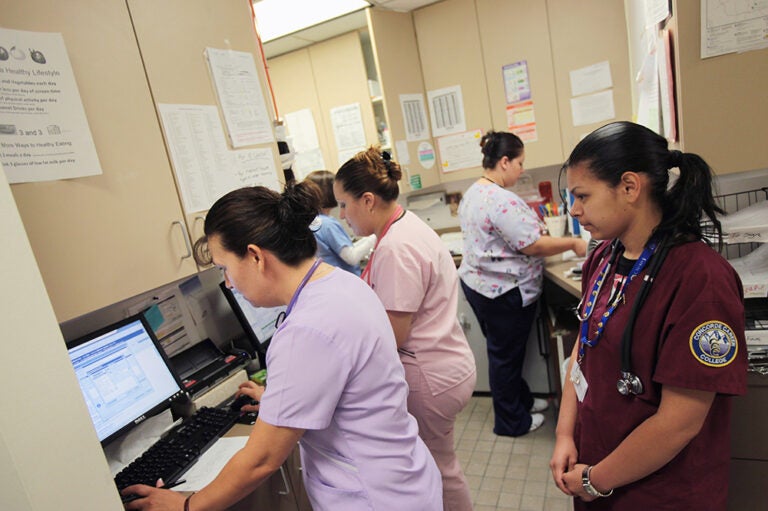Yesterday, the Medicare Trustees released a report that warns of a serious funding shortfall in the Medicare program. This shortfall threatens the future of Medicare, which provides health insurance to more than 57 million people who are ages 65 and over, or who are disabled.
The Trustees highlight a fundamental imbalance between rising Medicare spending and the revenue sources dedicated to fund it. According to the report, America’s aging population and increasing per-enrollee healthcare costs will drive sharp increases in Medicare spending, which will outpace the program’s funding — causing a shortfall. The Trustees are calling on policymakers to act with urgency to shore up this critical program by addressing this fundamental problem.
The Trustees project that:
- The beneficiary population will grow from 59 million in 2017 to 78 million in 2028 — an increase of over 30 percent — as more and more baby boomers turn 65 and become eligible for benefits.
- Reflecting this predictable demographic shift, Medicare spending will grow by nearly 60 percent over the next 25 years — climbing from 3.6 percent of GDP today to 5.6 percent of GDP in 2042 absent reforms.
- If lawmakers fail to act, the Hospital Insurance (HI) Trust Fund, which finances inpatient hospital and other expenses, will be fully depleted in 2029 — just 12 years from now. When the HI Trust Fund is depleted, Medicare will be unable to pay 12 percent of its bills.
The Trustees urge lawmakers to enact legislation soon to put Medicare on a sustainable path:
"Notwithstanding recent favorable developments, current-law projections indicate that Medicare still faces a substantial financial shortfall that will need to be addressed with further legislation. Such legislation should be enacted sooner rather than later to minimize the impact on beneficiaries, providers, and taxpayers."
Medicare spending is projected to grow significantly
According to the new report, Medicare spending remains on a sharp upward trajectory. The Trustees project that Medicare spending will climb significantly in the decades ahead — rising from 3.6 percent of GDP in 2017 to 5.6 percent of GDP in 2042. This is an increase of nearly 60 percent.
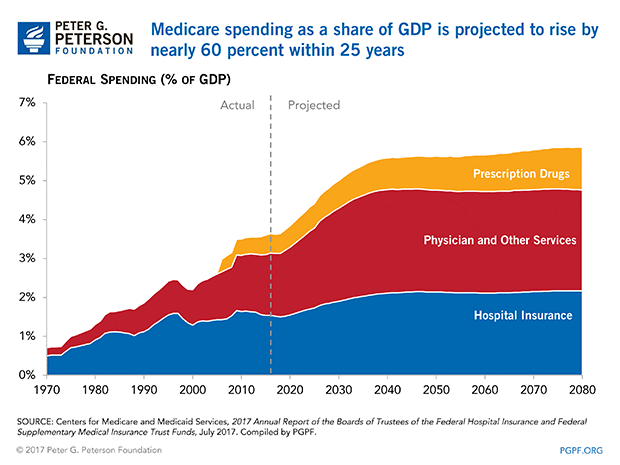
As Medicare spending increases, it will comprise a larger and larger share of the federal budget. In 1970, Medicare expenditures accounted for just 3 percent of total federal spending. Today, Medicare accounts for 15 percent of the budget and by 2042, it is projected to grow to 21 percent of the budget.
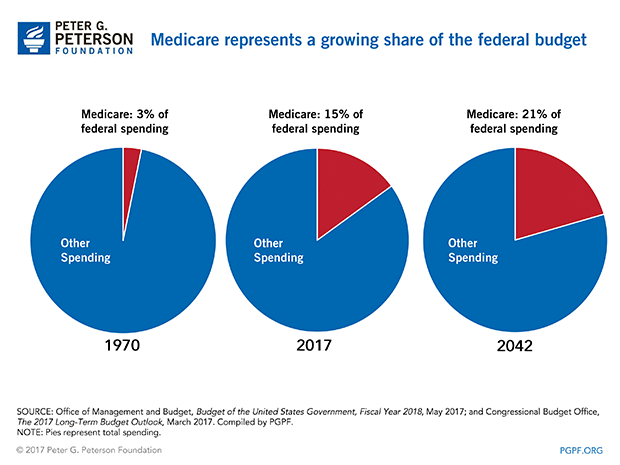
What is driving Medicare’s growing projected costs?
Projected growth of Medicare spending is driven primarily by two factors: growing numbers of beneficiaries and rising healthcare costs per beneficiary.
The aging of the population is a major factor driving Medicare spending over the next 25 years: as the baby boom generation of 76 million people turns 65, enrollment in Medicare will balloon. In 1990, there were 32 million people ages 65 and older. Today, there are 51 million; within 25 years, the Trustees project there will be 82 million people ages 65 and older.
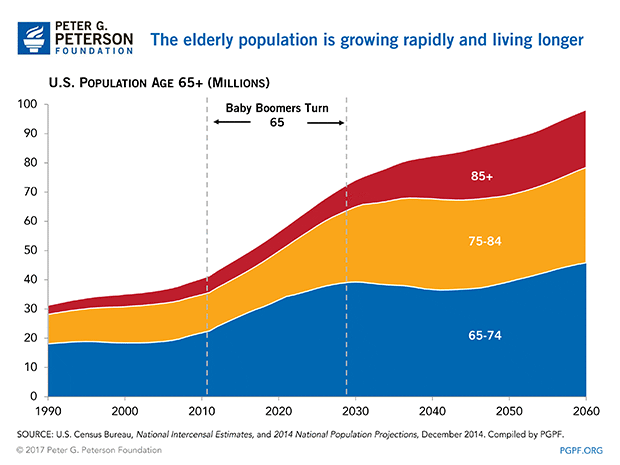
In addition, Americans have been living longer, which increases the length of time that people receive benefits from the program. In 1970, the average 65-year-old male was expected to live until age 79; today, he is expected to live until 84. The comparable life expectancies for women are 84 in 1970 and 87 today. While this is a welcome trend, it means that Medicare recipients will receive benefits for longer than they have in the past. In addition, medical costs typically increase with age, further driving increases in costs.
In addition to these demographic factors, the average cost of healthcare for Medicare beneficiaries is growing, and has been growing for more than four decades. In fact, the average cost per Medicare beneficiary (after adjusting for overall inflation) has more than tripled over the last forty years: the annual cost is now approximately $13,000 per beneficiary.
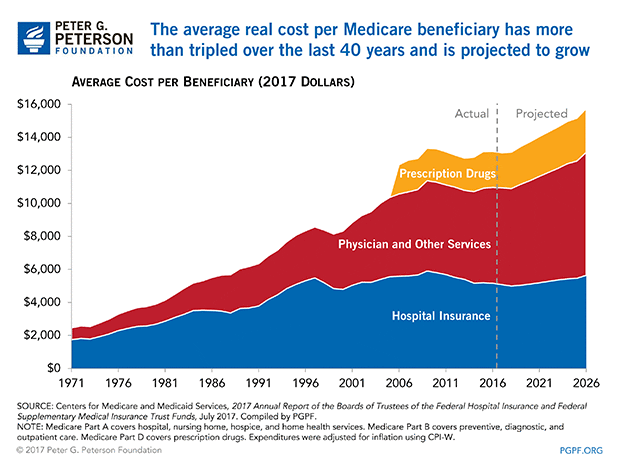
Medicare financing puts pressure on the federal budget
As Medicare spending has risen, the revenue sources that are dedicated to fund the expenditures — payroll taxes, premiums, and other receipts — are covering a smaller and smaller share of the actual costs. In 1970, Medicare’s dedicated income was able to fund 75 percent of the program, with the balance coming from transfers from the general fund of the Federal government. Today, payroll taxes, premiums, and other receipts are only able to fund 58 percent, with payroll taxes covering only 38 percent of the program’s costs. These shortfalls put increasing pressure on the rest of the federal budget.
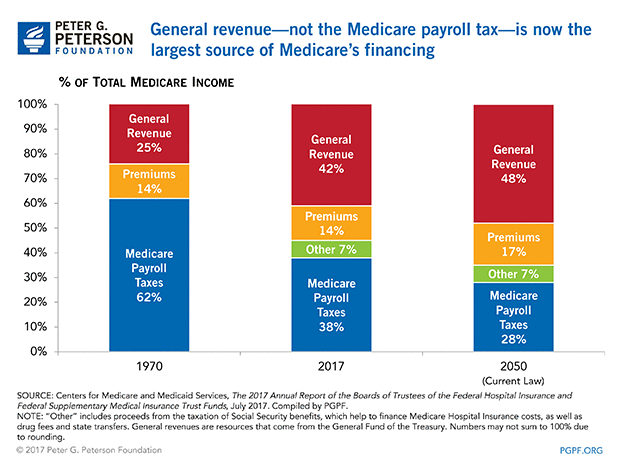
As a result of the imbalance between revenues and costs in the Medicare program, the Trustees estimate that Hospital Insurance (HI) Trust Fund will be fully exhausted by 2029. The HI program finances inpatient hospital care, skilled nursing, home health, and hospice care, and almost all Americans ages 65 and older are eligible. Once the HI Trust Fund balance reaches zero, spending on benefits cannot exceed incoming revenues and premiums. Unless policymakers act, the Trustees estimate that in 2029 the Medicare program will be unable to pay 12 percent of its HI bills. If this happens, payments to providers, patients, or some combination, would have to be cut.
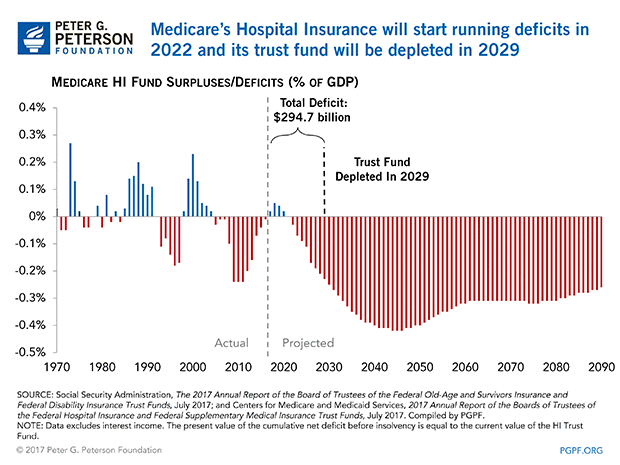
Medicare’s budgetary challenges go beyond hospital insurance. The Trustees also project rising spending on physicians, prescription drugs, and other healthcare services, which are funded by beneficiary premiums and general revenues. The trust fund for these programs cannot technically run out of money under current law because general revenue contributions must automatically cover any shortfalls in annual funding. However, the rising costs for these other health expenditures put pressure on the rest of the federal budget, consume resources that could be used for other programs, and ultimately lead to higher levels of federal debt and interest costs, which hurts the economy.
Medicare costs will be even higher under a less optimistic scenario
The Trustees provide two projections reflecting different policy assumptions: a current-law projection and an alternative projection. The current-law projection assumes that certain cost-control provisions of the Affordable Care Act (ACA) and the Medicare Access and CHIP Reauthorization Act (MACRA) will remain in place and be effective. The Trustees prepared an alternative scenario which assumes that these cost-cutting measures will be ineffective or will not be implemented. In that scenario, the Trustees project that spending could rise to 6.3 percent of GDP in 2042 — 73 percent above today’s levels and 12 percent higher than the level projected under the current-law projections.
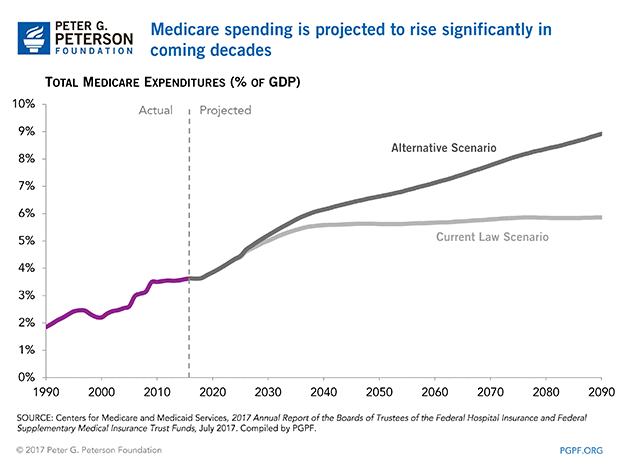
Conclusion
Medicare is facing a very predictable and long period of rapidly growing spending due to the retirement of the baby boomers and increases in longevity, as well as continued growth in healthcare costs per beneficiary. The Trustees call on Congress and the administration to act "with a sense of urgency" to address the growth in expenditures and the coming exhaustion of the HI Trust Fund. If done promptly, policy changes can be phased in gradually, minimizing the impact on beneficiaries. However, if Congress and the administration continue to delay needed reforms, Medicare enrollees could see more significant and sudden changes to the benefits that they rely on. Policymakers should work together to stabilize and strengthen this important program for generations to come, while also relieving the pressure it places on the rest of the budget.
Further Reading
Quiz: How Much Do You Know About Healthcare in the United States?
The United States has one of the largest and most complex healthcare systems in the world. Take our healthcare quiz to see how much you know about the cost and quality of the U.S. healthcare system.
How Did the One Big Beautiful Bill Act Change Healthcare Policy?
The OBBBA adds significantly to the nation’s debt, but its healthcare provisions lessen that impact by $1.0 trillion.
Infographic: U.S. Healthcare Spending
Improving our healthcare system to deliver better quality care at lower cost is critically important to our nation’s long-term economic and fiscal well-being.

